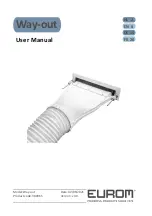
EVACUATION PROCEDURES
Connect the refrigerant pipes (both the liquid and gas pipes)
between the indoor and the outdoor units.
Remove the service port cap of the stop valve on the side of the
outdoor unit gas pipe.(The stop valve will not work in its initial
state fresh out of the factory (totally closed with capon).
Connect the gage manifold valve and the vacuum pump to the service port
of the stop valve on the gas pipe side of the outdoor unit.
Run the vacuum pump for more than 15 minutes and at this time
confirm that the pressure gage indicates -0.1Mpa (-76cmHg).
Check the vacuum with the gage manifold valve, then close the gage manifold valve,
and stop the vacuum pump.
Leave it asis for one or two minutes. Make sure the pointer of the
gage manifold valve remains in the same position.
Close
Open
Hexagonal
wrench
Stop
valve
Connection
pipe
Gage
manifold
valve
Stop valve Liquid pipe
Stop valve
Hexagonal
wrench
Gas pipe
Caps
Service port
Vacuum pump
Remove the gage manifold valve quickly from the service port of the stop valve.
After refrigerant pipes are connected and evacuated, fully open all
stop valves on gas and liquid pipe sides. Operating without fully opening
lowers the performance and causes trouble.
Pipe length 7m maximum
No gas charge is needed.
Pipe length exceeding 7m
Charge the prescribed
amount of gas.
Tighten the cap to the service port to obtain the initial status.
Retighten the cap.
Leak test
5. REFRIGERANT SYSTEM DIAGRAM
16
















































